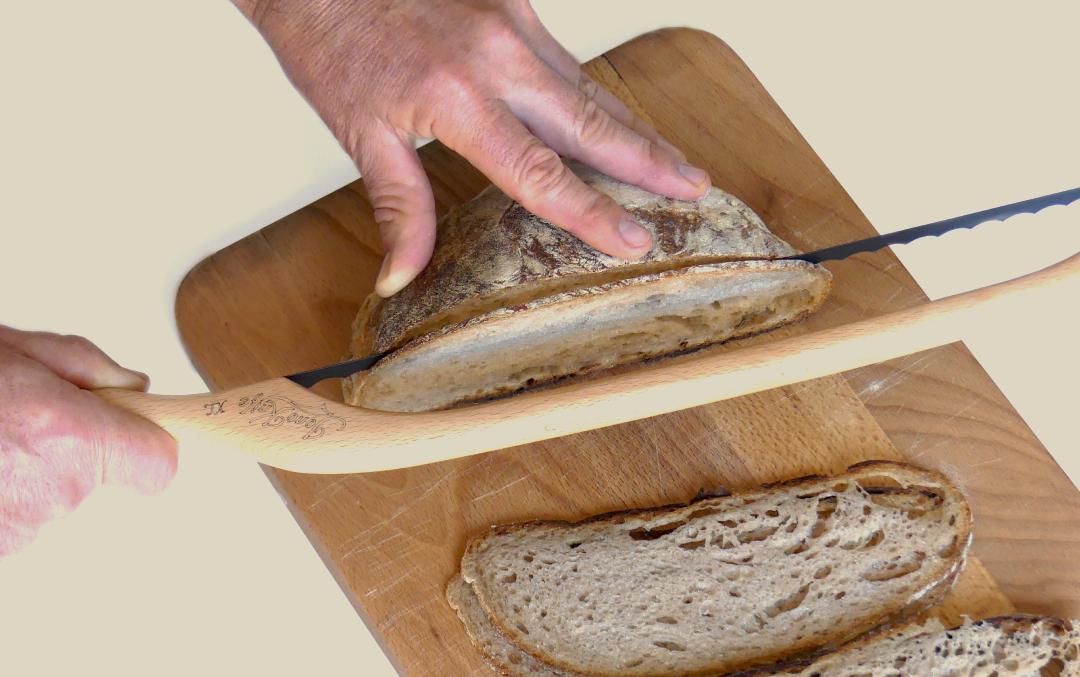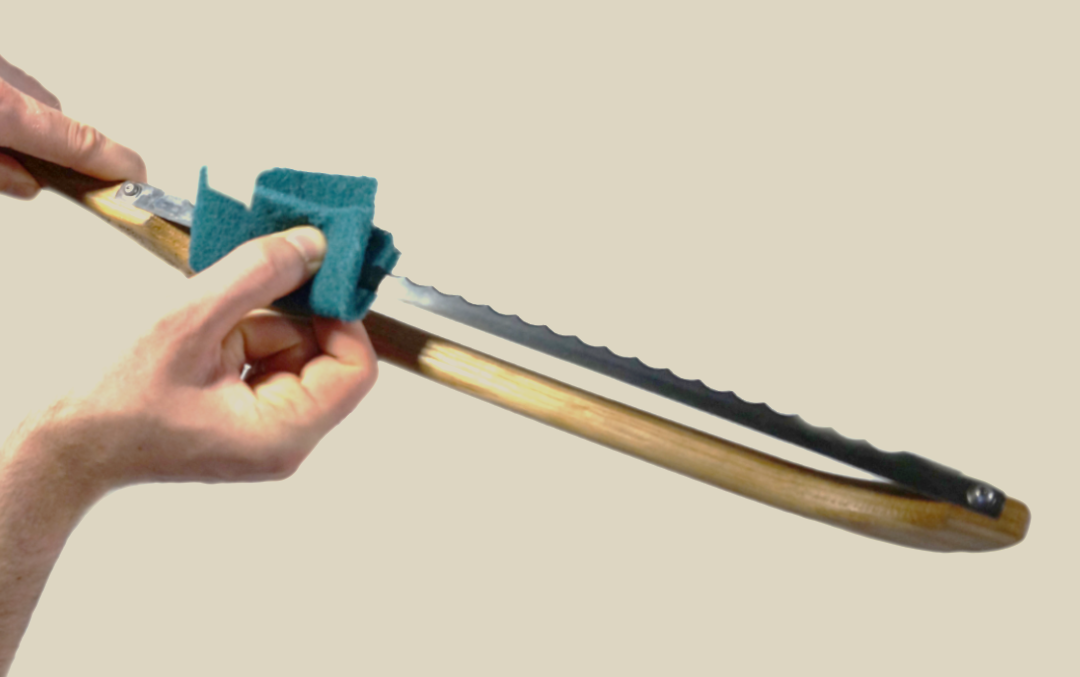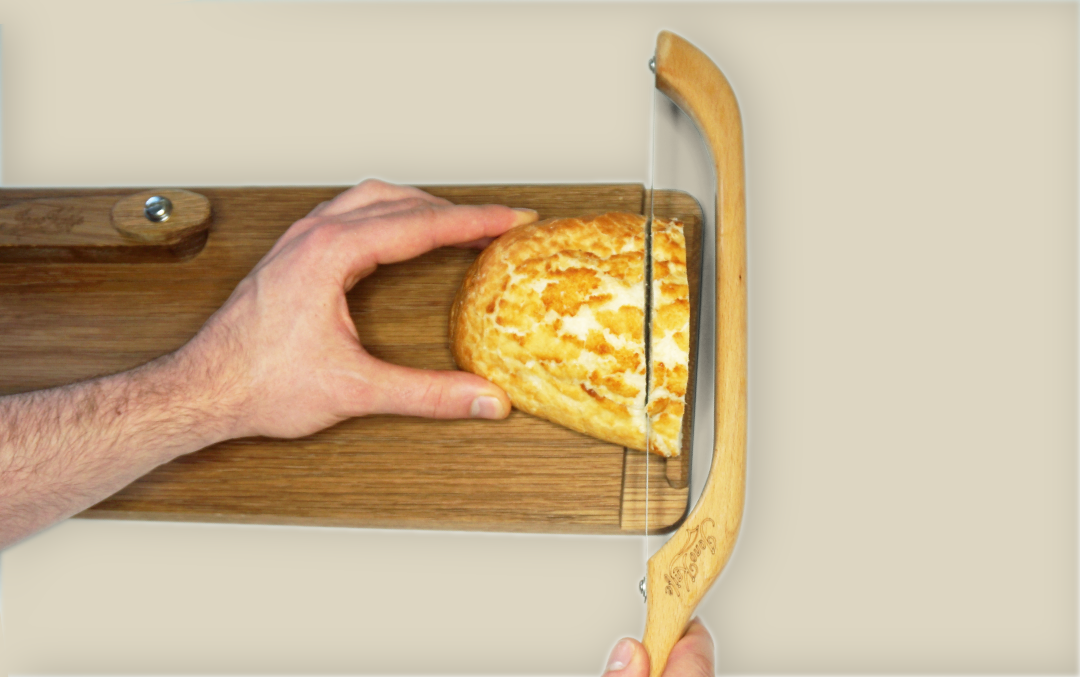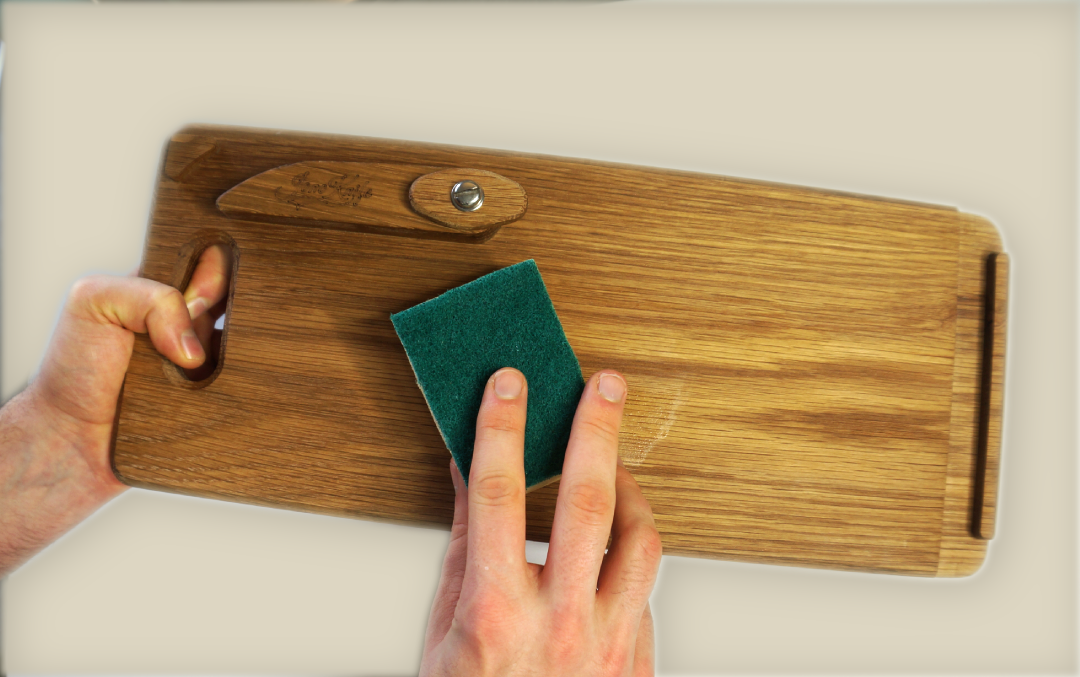Using your JonoKnife bread knife
Removing the Bread Saw Guard
All JonoKnife fiddle bow bread saws come with a magnetic blade guard included. For your safety your fiddle bow knife should be stored with the guard attached. Remove the guard by pulling it downwards away from the blade. To re-attach the guard after use; fit it from the side. You should never move your hand towards the blade teeth. The teeth are SHARP! If you own a JonoKnife breadboard then the magnetic guard is not necessary as the knife stores safely attached to the board.
Best Bread knife cutting technique
Use a gentler grip to hold the handle than used for a conventional breadknife. Make sure the handle of your fiddle bow knife is level and not tilting down to the left or right before you cut. Slice with long forward and backward strokes. Apply minimal downward pressure, especially when cutting bread straight from the oven!
Cleaning up the fiddle bow knife
When slicing most breads your JonoKnife should stay clean. Simply tapping the knife against the counter should get most crumbs to fall off. If however you do need to clean or polish the blade please follow the blade specific cleaning instructions in the FAQ below. Regardless of the specific cleaning solution, the hand grip technique remains the same. Use a thick cloth / cleaning pad between your fingers and the blade and only rub the blade with your hand coming from behind the blade – never from the toothed edge.
Bread knife – Frequently Asked Questions
1. Can this bread knife be used by someone who is left handed?
All JonoKnife sizes and wood choices come in a choice of either right or left handed version. When buying our fiddle bow knife specifically for a left-handed person, make them feel special by getting the knife made just for them!
2. I am right-handed but my partner is left. Which knife?
For a mixed handed couple, the right-handed knife is most often the best bet. This is because, in general, left handers are more adept at using their wrong hand due to a lifetime of having to fit into a mostly right handed world (bless you left handers!) Many left handers actually report that they cut bread better using their wrong hand with a JonoKnife than using their left hand with a regular bread knife!
3. Can a right-handed JonoKnife be converted to a left one and vice-versa?
No. The handle of our fiddle bow knife is made to be either right or left handed in the workshop. As the blade height is thinner than the handle is thick, the blade is screwed on to the handle in an offset position. If the blade were flipped the teeth would not reach the bottom of the handle on the reverse side.
4. How do I clean my JonoKnife handle?
Slicing most kinds of bread does not really dirty a bread knife so cleaning is often not necessary. If necessary though, a simple wipe down with a damp or wet rag can be done. Never submerge the knife in water. The regular use of water or soap and water will cause the wood finish to dull over time.
5. What if the wood finish dulls over time?
This should not happen if the knife handle is not wet washed or wiped frequently. However, if the wood does dull over time then just apply a coat of food-safe wood oil.
6. Can I put my JonoKnife in the dishwasher?
No. This will lead to the wood weathering very badly and to reduced blade tension.
7. How do I clean the blade?
When cutting dry bread, the blade seldom gets dirty. If you do need to clean the blade though then remember, safety first! Only clean / dry / polish the blade from behind and always have a thick cloth or cleaning pad between your fingers and the blade. Your hand / fingers should never face the teeth. As the XL and the Original knife use a carbon steel and stainless steel blade respectively, they have different cleaning considerations. See points below for cleaning either blade.
8. How do I clean the Original knife’s stainless steel blade?
You can use a wet cloth or cleaning pad with soap on the stainless steel blade. The blade should be dried afterwards but will not rust if it is left to drip dry.
9. How do I clean the XL knife’s carbon steel blade?
Avoid wet-wiping the XL’s carbon steel blade as much as possible. If you have to wet wipe it be sure to dry it off afterwards. It is better to wipe the carbon steel blade clean with vinegar rather than water as vinegar will not cause rust to develop. In fact, vinegar actually removes rust whilst also cleaning the metal.
10. What if tarnish or rust develops on my XL blade?
Regardless of cleaning technique and frequency some tarnishing / rust spots may appear over time due to moisture in the air. This is the unfortunate downside of carbon steel blades. The upside is that carbon steel can tackle much tougher crusts and stay sharp a lot longer than stainless steel. Cleaning the blade with vinegar instead of water is a great way of avoiding rust and can even remove rust. If a blade does rust or tarnish over time for whatever reason and vinegar can not remove the build up, a metal polish like Brasso or Silvo on a thick cleaning pad can be used.
11. How long will my JonoKnife stay sharp?
Depending on which JonoKnife you own (Standard Size or XL) the blade should stay sharp for anything from two years to a lifetime. Your blade’s lifetime depends entirely on its frequency of use and what foods you cut with it. The bread most likely to reduce blade life is sourdough or some other really hard crusted bread. If you cut a lot of this kind of bread it’s best to use the XL knife which comes with a carbon steel blade. You can also use an AnySharp to sharpen any size of the JonoKnife, see it in action here.
12. Can I sharpen my JonoKnife?
JonoKnife blades can be sharpened with an AnySharp knife sharpener, you can see our custom-made JonoKnife AnySharp in action here. Though it is easier to use an AnySharp, we also offer a blade replacement service. Please get in touch for further details.
13. Can I replace the blade at home?
Theoretically yes. Very few people have the equipment required to fit a new blade at home though. When replacing the blade, the wooden handle has to be compressed from end to end to take the tension off the blade. It takes about 150 – 200kg of force to achieve this compression; one would need a long sash clamp. This is a tool that most people do not have. For this reason we offer a blade replacement service.
Using your JonoKnife Breadboard
Storing your board and knife
Our breadboard provides a safe, convenient and functional storage solution for your JonoKnife. Once your JonoKnife is latched to your board safely, the breadboard can be stored anywhere on a kitchen worktop. You may otherwise decide to make use of the handle grip to hang your breadboard and knife up on a secure hook. However you decide to store your breadboard, whether kept on its side or suspended vertically, the knife will remain safely attached to the board.
Using the ‘Crust-buster’ groove
One of the most challenging aspects of slicing tough, crusty bread is getting through the bottom crust. We have designed our breadboard with a ‘crust-buster groove’ to overcome this difficulty. The grove works by allowing the blade to pass one centimetre below the bottom crust, enabling the blade to meet the bottom crust at an angle, which is more effective for tackling thick crusts. To use the groove effectively, position your bread over the groove in proportion to your desired slice width. Once your bread is in place, slice your bread whilst keeping the blade aligned with the groove. The crust-buster groove also helps to avoid needless scouring of the board top surface and needless dulling of the blade.
Cleaning
When finished slicing, shake or wipe off your board with a damp clothe, latch your JonoKnife to it and return the knife and board set to its place. If it is necessary to wash your board, use a damp cloth to wipe away any residue stuck to the surface. Do not submerge your board in water nor put your board in a dishwasher. This is because the board is made from single piece of natural wood. If too much water penetrates the wood the board may warp. For this reason we recommend that your breadboard be used only for cutting bread and not fruit and vegetables to reduce the need for vigorous washing.
Breadboard – Frequently Asked Questions
1. Is the wood finish of the breadboard & knife the same?
Our knives are finished with Danish oil, but the boards are finished with mineral oil. Danish oil will always give a harder, shinier and more resilient finish than pure and very simple mineral oil. This is because Danish oil contains urethane and a few other chemicals that contribute towards resilience and shine. Though the Danish oil we use is food safe, one would still not desire such oil to mix in with food, which could change the taste of the food. This could happen with a breadboard due to the wooden fibres becoming roughed up by the knife cutting blade. Mineral oil produces no taste nor any other kind of change if food is contaminated with it. For this reason, pure white mineral oil is the top choice for wooden cutting boards and blocks. This very practical decision to finish the knife handles and boards in a different oil though will mean that your knife will have a higher sheen finish to it than your board will – this is pretty standard in a kitchen anyway.
2. How can I protect the board from wear?
The correct use of the “crust-busting” groove as explained above will drastically help to reduce board wear. The correct cleaning procedure (see ‘Cleaning’ section) will also help with this.
3. Can I cut non-bread items?
We recommend that your breadboard be used only for cutting bread and bread type items. Washing the breadboard too often is not recommended. The need to rinse off the board is reduced if it is not used to slice fruit and vegetables (see “Cleaning” section above).
4. Do I need to oil the board?
Oil the board if it ever gets to a state where it starts to look worn. You can use any wood oil, but we recommend the oil we use: pure white food-grade mineral oil, otherwise known as cutting board oil. Cutting board oil is fairly inexpensive and can easily be found online. A small bottle of it may last for years. However, your board may never or seldom need oiling if bread is cut over the Crust-busting groove whenever possible. Doing so will spare the board surface from cut marks and keep the board looking new for longer.
5. Do I still need the magnetic blade guard?
It is not necessary to fit the magnetic blade guard to the knife whilst the knife is latched to your breadboard. The board serves as a blade protection device.







